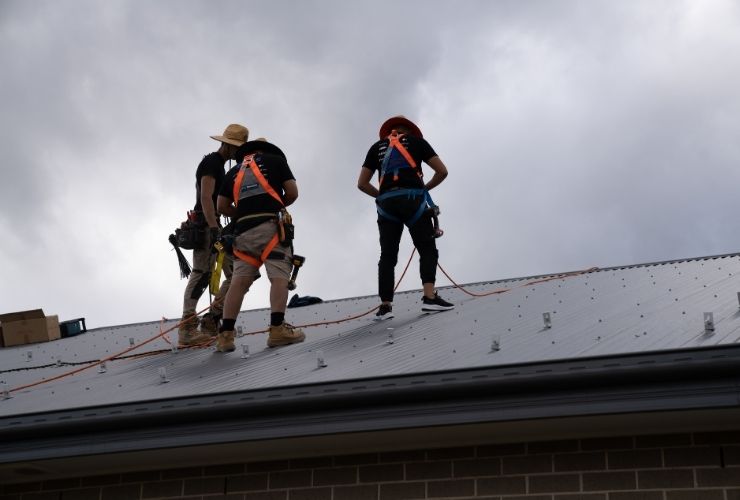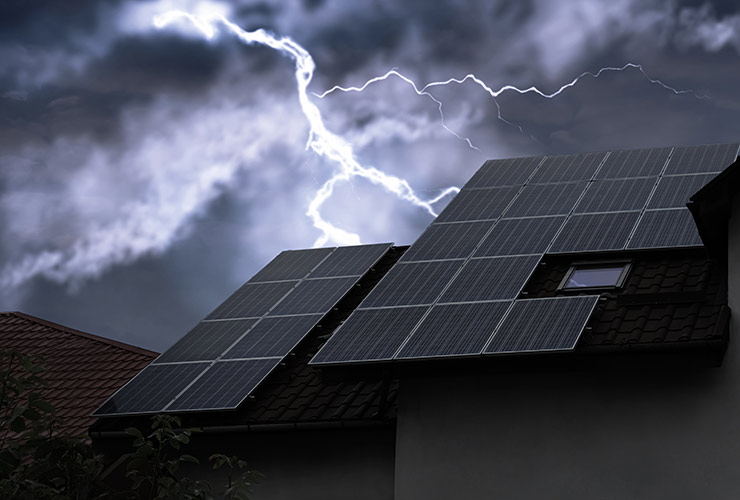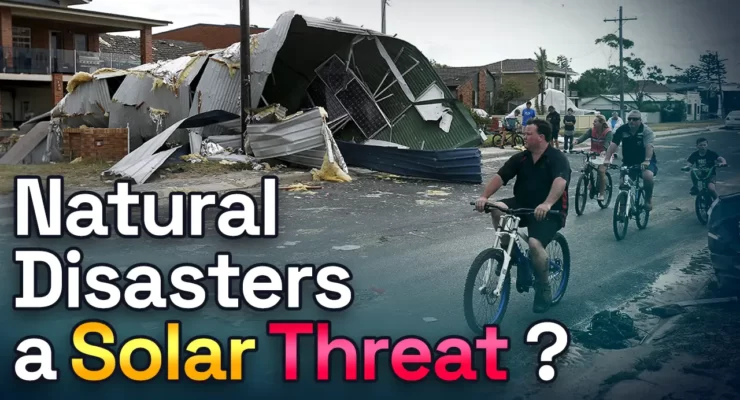Fast read
Solar panels can continue to function in various weather conditions, but extreme weather can impact their efficiency and, in some cases, can cause damage. While solar panels can generate power in bad weather, severe conditions may pose challenges. Here's a breakdown of how different weather conditions affect solar panel production:
- Cloudy and overcast days: These conditions reduce sunlight intensity, leading to decreased energy production. However, it doesn't cause physical damage, and efficiency typically returns when skies clear.
- Rain: Solar panels can still produce energy in rain, albeit at least 50%f less and in strong rain as much as 70% less. On a positive rain can also clean panels, improving performance afterwards.
- Snow: Snow accumulation blocks sunlight from reaching solar PV cells, rendering the panels pretty much inactive until the snow melts or is cleared.
While the weather can temporarily impact efficiency, most panels return to optimal capacity once normal conditions resume. Investing in high-quality, durable solar systems ensures resilience against various weather challenges.
Will extreme weather affect my solar panels?
The simple answer is that solar panels and as such a full solar panel system can still function in extreme and bad weather conditions. However, extreme weather, which diminishes the available sunlight for your solar panels, will affect the efficiency of the panel’s energy production.
Although solar panels can produce energy in bad weather, during extreme conditions, damage may occur. This means that if you reside in a location where extreme weather conditions are common, having a solar installation that has extra safety features is important. Otherwise, you may end up spending more than you expected for repairs.
For example, if you are located in areas that can have cyclones such as Townsville, Cairns or Darwin, your solar rails will require additional brackets to ensure the system can withstand the local wind forces. Your solar panel installer also needs to observe the clamp zones on the panels as recommended by the manufacturer.
Ignoring these issues compromises the structural strength of the panel and framing system, making cracked glass or other panel damage more likely in extremely heavy winds.
Quality brands test their solar panels for extreme weather conditions, including smaller hailstones. Therefore, always prioritise quality products over price when purchasing solar panels.
How do different weather conditions affect solar panel production?
Cloudy and overcast
The worst conditions for solar panel output are cloudy, overcast or rainy days. Although this poses no risk to the solar system physically, it reduces production and efficiency significantly.
Nevertheless, when solar panels are being produced and designed, manufacturers consider different weather conditions. This means they know that solar panels will be exposed to the elements.
Cloudy and rainy weather is not ideal for production. However, the effects of this weather are temporary. It does not cause physical damage to the PV array.
Clouds will block sunlight, reducing the intensity of the sun irradiation that reaches the solar panels. This reality will lead to a decrease in energy production

Driving rain
Although solar panels can still produce energy when it’s raining, they are most effective when exposed to direct sunlight. You should expect your solar panels to produce roughly 15%-35% of their optimal production capacity on a rainy day. Of course, the amount of electricity produced on a rainy day will vary depending on how heavy the rain is. However, after the rain, your panels should, in most cases, work more efficiently since the water would have washed away any dust or dirt on the panel.
Usually, panels are rated IP67 or IP68, meaning even in driving rain the water will not enter the panel in any form. Rain can only get into the solar panel and cause damage if the backing sheet, seals, or lamination are broken. This can lead to corrosion and eventually make the solar module stop working.”
Snow
A less common weather condition in Australia, yet one that can cause issues, is snow. When snow accumulates on the panel, sunlight cannot reach the solar photovoltaic cells, preventing electricity generation. Although lightly covering the panels won’t cause permanent damage, your solar panels will be inactive until the snow is cleared or melts away.
If snow builds up to a solid height, the weight of wet snow can, in extreme circumstances, bend panels or their frames and cause microcracks. Luckily, such events are extremely rare in Australia.
Hail
Hail can be one of the most dangerous extreme weather your solar system can face. These stones during a storm can range in size from small ice pellets to large tennis balls. The impact of these large ice balls can cause cracks and chips in your panels, damaging them beyond repair.
Modern solar panels are designed to withstand hailstones with a diameter of around 25 mm, but if the stones get bigger than that severe panel damage can occur. Luckily in such cases, the home insurance will cover the replacement of the panels.
Hurricanes, tornadoes and cyclones
This weather is rare in Australia. Cyclone Tracy hit Darwin on Christmas Day in 1974 and caused a lot of damage. Most solar panel manufacturers produce solar panels that can withstand wind speeds up to 220km/h.
This is higher than Tracy – which was measured at 205 km/h and most tornadoes and hurricanes, which average 160 km/h. In these conditions, the main concern is debris hitting the panels and causing the glass to crack. Once the panel glass is cracked, it cannot be repaired, which leads to failure.
Lightning
If you’re extremely unlucky, a lightning bolt might strike your panels or solar inverter. When this happens, it can cause extreme damage to your system, ranging from melting a singular panel junction box or connector to damaging and shutting down the entire system.
Manufacturers of inverters and panels, as well as solar system installers, must follow certain guidelines to minimise equipment damage in such weather events.

Extreme temperatures
Extreme temperatures, both hot and cold, can affect solar panels. High temperatures can make the panels scorching hot, temporarily reducing their efficiency.
When installing solar panels, it’s important to leave a gap (usually 5-10mm) between them to allow for thermal-related expansion under heat.
In installations where panels are tightly butted up against each other, such as two rows stacked on top of each other, the expansion caused by heat can create significant pressure between the top and bottom panels.
Eventually, such a poor installation practice will lead to the shattering of the glass covering the panels.
Potential induced degradation
Heat combined with humidity can also cause a degradation phenomenon known as Potential-induced degradation. The high voltage combined with heat and humidity causes degradation of the cells in the panel at the high voltage end of the string of panels. This can be exacerbated in coastal areas where salt water can hit the solar panel.
An extension of this process is light and elevated temperature-induced degradation in which the combination of intense light, heat and humidity can lead to accelerated degradation of panel performance where the cell technology has not properly been pacified in manufacture. This has seen panels with performance drop of up to 30% over the initial five years or so after installation. To read more about Potential Induced Degradation, please refer to the GSES page on it here:
So can the weather affect solar panels?
To ensure your solar system can withstand extreme weather conditions, make sure you choose a CEC-certified, local, and trustworthy installer. They should install the panels with enough brackets, observe the clamp zones, and avoid butting panels hard against each other.
Furthermore, ensure you select panels and other components from well-known brands so you can have confidence in their quality and warranty abilities.



